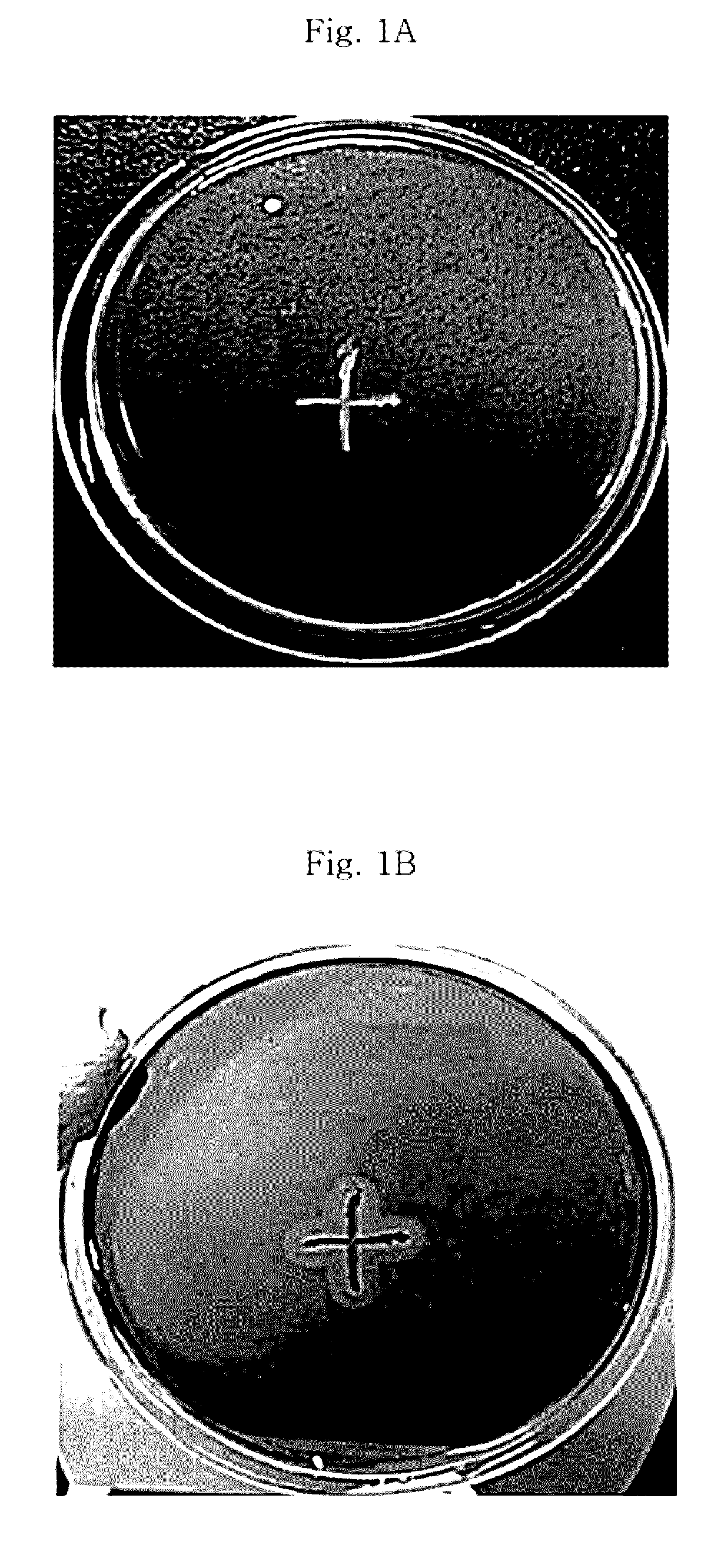Paenibacillus sp. caa11 capable of saccharification and fermentation of cellulose and transformed strain thereof
a technology of cellulose and paenibacillus, which is applied in the field of paenibacillus sp. caa11, can solve the problems of low price competitiveness of biofuel, unsatisfactory biofuel production, and high cost of saccharification enzymes used in the saccharification process, and achieve the effect of improving the biomass saccharification capability of paenibacillus sp
- Summary
- Abstract
- Description
- Claims
- Application Information
AI Technical Summary
Benefits of technology
Problems solved by technology
Method used
Image
Examples
example 1
Isolation of Cellulose-Degrading Bacterium Paenibacillus sp. CAA11
Example 1-1
Harvesting of Strains
[0066]In order to isolate a strain that can produce chemicals directly using cellulose, soil samples taken from cellulose-rich environments such as Dongmak Beach, Mt. Gwanak and Mt. Jiri of Korea and Indonesia were plated onto plate media containing 10 g / L cellulose. After culturing overnight at 37° C. in an incubator, the cultured strains were screened primarily. The purified and isolated strains were cultured again in cellulose media and screened secondarily by investigating whether the isolated strains can degrade cellulose through Congo red staining and destaining. The composition of the medium for culturing the isolated strains is shown in Tables 1 and 2.
TABLE 1Medium compositiong / LK2HPO45KH2PO43(NH4)2SO42MgSO4•7H2O0.4Peptone0.5Beef extract0.3Yeast extract1CaCl2•2H2O0.1Trace elements1 mLCellulose10
TABLE 2Trace elementsHCl1ml / LZnCl270mg / LMnCl2•4H2O100mg / LH3BO360mg / LCoCl2•6H2O200mg / L...
example 1-2
Phylogenic Analysis and Identification of Strain
[0068]The genes of the strain harvested from Dongmak Beach, which showed the highest cellulase activity, were amplified by PCR. Primers used for the PCR amplification were 27F (5′-AGAGTTTGATCTGCTCAG-3′, SEQ ID NO 1) and 1492R (5′-AAGGAGGTGATCCAGCCGCA-3′, SEQ ID NO 2), and reaction conditions for the PCR were 94° C. for 5 minutes followed by 30 cycles of 94° C. for 1 minute, 55° C. for 1 minute and 72° C. for 1 minute and 30 seconds with a 10-minute incubation at 72° C. 16S rRNA nucleotide sequencing of the PCR products was conducted by Macrogen. A sequence of SEQ ID NO 3 was obtained and the strain was named as Paenibacillus sp. CAA11 after phylogenic analysis (FIG. 2).
SEQ ID NO 3: CTATACTGCAGTCGAGCGGAGTTATTTAGAAGCTTGCTTCTAAATAACTTAGCGGCGGACGGGTGAGTAACACGTAGGCAACCTGCCTGTAAGACTGGGATAACTACCGGAAACGGTAGCTAATACCGGATACACAAGTTCCTCGCATGAGGGATTTGGGAAAGACGGAGCAATCTGTCACTTACGGATGGGCCTGCGGCGCATTAGCTAGTTGGTGGGGTAACGGCTCACCAAGGCGACGATGCGTAGCCGAC...
example 3
Screening of Promoter for Use in Transformation for Overexpressing Protein in Paenibacillus sp. CAA11
[0090]Establishment of method for transforming Paenibacillus sp. CAA11 Because no transformation method is established for Paenibacillus, various vectors including a cloning vector for use in Bacillus, a vector for genomic insertion and a vector for labeling a target genome were acquired from the Bacillus Genetic Stock Center (BGSC, USA).
[0091]A method for introducing DNA into CAA11 was established by trying various transformation techniques for DNA insertion under various conditions. Because Paenibacillus sp. CAA11 is a Gram-positive bacterium having a thick cell wall, 0.5 M sorbitol was added when preparing the cells to be transformed to raise osmotic pressure in order to increase the efficiency of DNA introduction. After conducting transformation using plasmids of various sizes, it was confirmed that the plasmids were successfully introduced into CAA11 as shown in Table 4.
TABLE 4P...
PUM
| Property | Measurement | Unit |
|---|---|---|
| pH | aaaaa | aaaaa |
| pH | aaaaa | aaaaa |
| pH | aaaaa | aaaaa |
Abstract
Description
Claims
Application Information
 Login to View More
Login to View More - R&D
- Intellectual Property
- Life Sciences
- Materials
- Tech Scout
- Unparalleled Data Quality
- Higher Quality Content
- 60% Fewer Hallucinations
Browse by: Latest US Patents, China's latest patents, Technical Efficacy Thesaurus, Application Domain, Technology Topic, Popular Technical Reports.
© 2025 PatSnap. All rights reserved.Legal|Privacy policy|Modern Slavery Act Transparency Statement|Sitemap|About US| Contact US: help@patsnap.com



